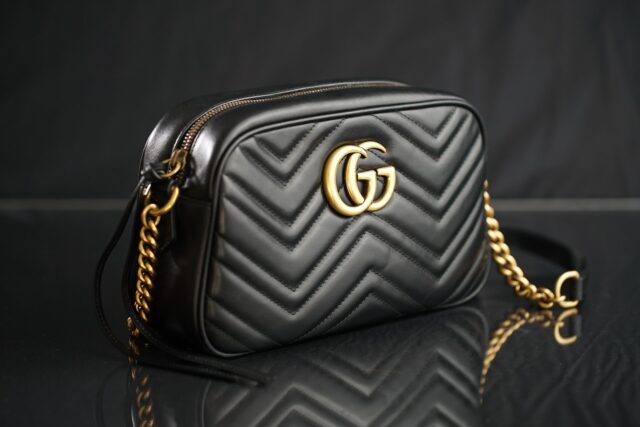It’s no surprise that Gucci is one of the most counterfeited premium designer labels on the planet. Gucci, along with Chanel, Hermes, and Louis Vuitton, is at the pinnacle of the luxury fashion industry, with so many classic designs and design elements in their handbags.
Gucci handbags stand out from the crowd because to high-quality materials, excellent craftsmanship, classic designs, and characteristic Gucci flair like bamboo handles, horsebit closures, and the GG monogram canvas.5
5 Proved Steps for Gucci authentication check
When looking for pre-owned Gucci handbags, it’s vital to know your way around the real stuff and be able to spot fakes, since there are a lot of them out there. The suggestions and red flags in the following article will help you conduct a DIY 5-step authenticity check on a pre-owned Gucci bag.
Step 1. First, look at the serial number tag:
- A rectangular leather tag (with sharp right angles) opposite the bag’s front fastening may be found inside the handbag near the inside zippered pocket.
- Keep an eye on both sides of this rectangular tag: the front should contain three lines of heat-stamped text, while the back will include the serial number.
- Ensure that the trademark ® in a circle appears on the top line of this tag.
- “GUCCI” should be written in all-capitalized signature Gucci typeface just below. Examine the typeface closely: the ‘G’ and the two ‘C’s should be circular, almost like completed circles.
- “Made in Italy” should be written in all lowercase characters just below this.
- Make sure the entire heat stamp is justified in the middle and that the typeface is genuine.
- To determine if the typefaces on the tag of the bag in question match, look at the image below.

Step 2. Examine the Materials and Workmanship
Gucci, being a top luxury brand, only uses the best quality materials and painstaking craftsmanship to create its handbags. This is why even extremely old Gucci handbags from the 1980s and 1990s may be found in wonderful, like-new condition.
When purchasing for a pre-owned Gucci bag, the bag’s quality should be apparent at first glance or touch. Feel the material the bag is made of if you have the capacity to physically inspect it.
Gucci’s materials seem sumptuous to the touch, whether they’re Gucci’s distinctive GG monogram canvas, Guccissima “the most Gucci” leather, calf or suede leather, or the rare exotic crocodile skins. Counterfeits typically utilise low-cost leather that is machine-made and polished with low-quality chemicals, giving it an artificial appearance, texture, and even odour.
The quality of the hardware and craftsmanship can be seen. Examine the serial number tag; it has rounded edges and does not follow normal numerical codes. The gold print on the front face of the tag is also unique, as is the lack of the ® logo found on current Gucci bags.

Step 3. Examine the Stitching in.
Gucci handbags are known for their exquisite stitching, with threads that are sometimes, but not always, the same colour as the bag. If the stitching is uneven, there are cracks or holes in the threads, or the bag is fraying, it is most likely a fake.
Step 4. Enjoy the Hardware
Gucci hardware differs substantially among its many handbag types, owing to the fact that the hardware is where Gucci lays considerable design attention, which has evolved dramatically over the years (even the Gucci emblem has recently changed from interlocking G’s to the Marmont GG overlapping form).
The horsebit closure, the piston lock on Jackie O Hobo bags, and the bamboo closure and bamboo handles are some of the most recognisable hardware found on Gucci bags.
While the many varieties of Gucci hardware have apparent variations, they all have one thing in common: excellence. When you feel the hardware on a genuine Gucci handbag, you’ll notice how heavy and high-quality the metal is. It will never be light, inexpensive, scratch-prone, or plastic-coated.
Gucci’s bamboo is carefully handmade over an open flame and lacquered to create that exquisite bronze finish, which dates back to WWII’s leather and metal shortages. It, too, has a thick and luxurious feel in the hand.

Step 5: Look for a Certificate of Authenticity.
If you’re looking for a pre-owned Gucci bag, you could come across a “controllato” card. It’s grey in colour, with a logo in the ‘GUCCI’ typeface, ten digits, and the word “controllato” written in all lowercase letters.
Every new real Gucci bag comes with this card, but don’t be deceived. If counterfeiters can duplicate a whole bag, they can easily reproduce a card. Accepting the appearance of this card as confirmation that the bag is genuine is not enough.
However, you should not be worried if the pre-owned Gucci bag does not come with a “controllato” card. These are commonly misplaced (since they are not unique to your bag, but rather are generic with all new Gucci bags), and the bag can still be legitimate without one.
In fact, many respectable luxury resale shops will include an authenticity card that certifies the bag’s authenticity. These same resellers will usually provide a money-back authenticity guarantee, and the best will offer a lifetime authenticity guarantee, rather than merely one that expires after the standard 30-day return period.

Because Gucci has developed so many classic shapes and advancements throughout the years, authenticating Gucci purses may appear challenging at first. You’ll be well on your way to detecting fake Gucci handbags if you understand the core of the traits shared by all Gucci handbags.
Check out our other tutorials to discover how to verify handbags from other major luxury labels like Chanel, Hermes, and Louis Vuitton:
Authentication Guide for Chanel
Authentication Guide for Hermes
Authentication Guide for Louis Vuitton









